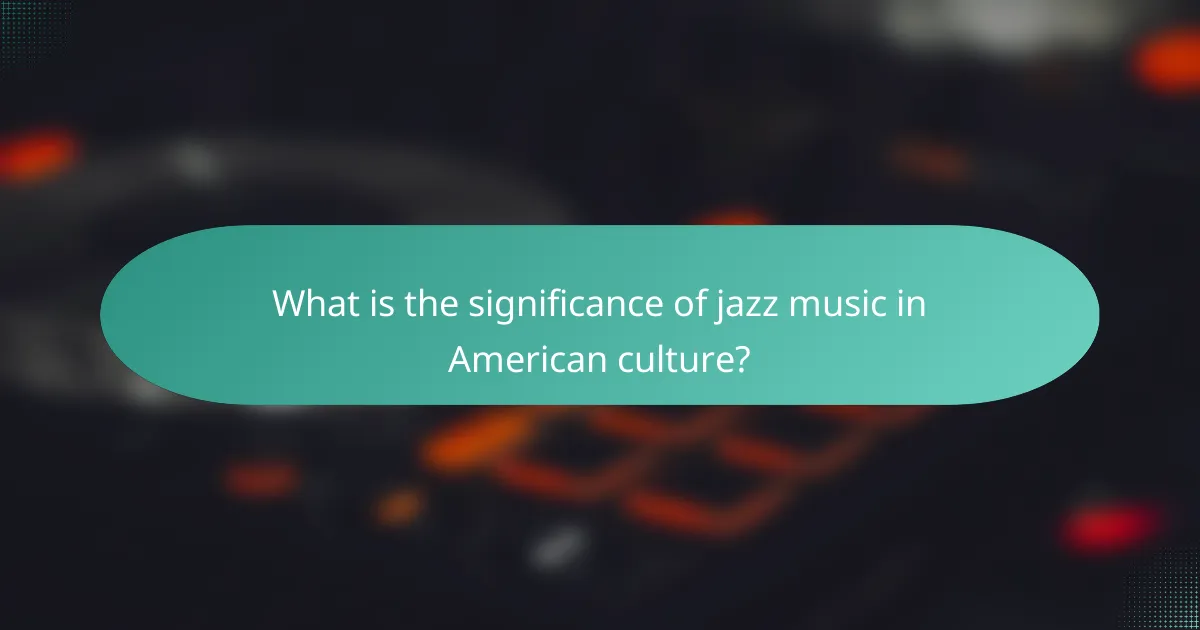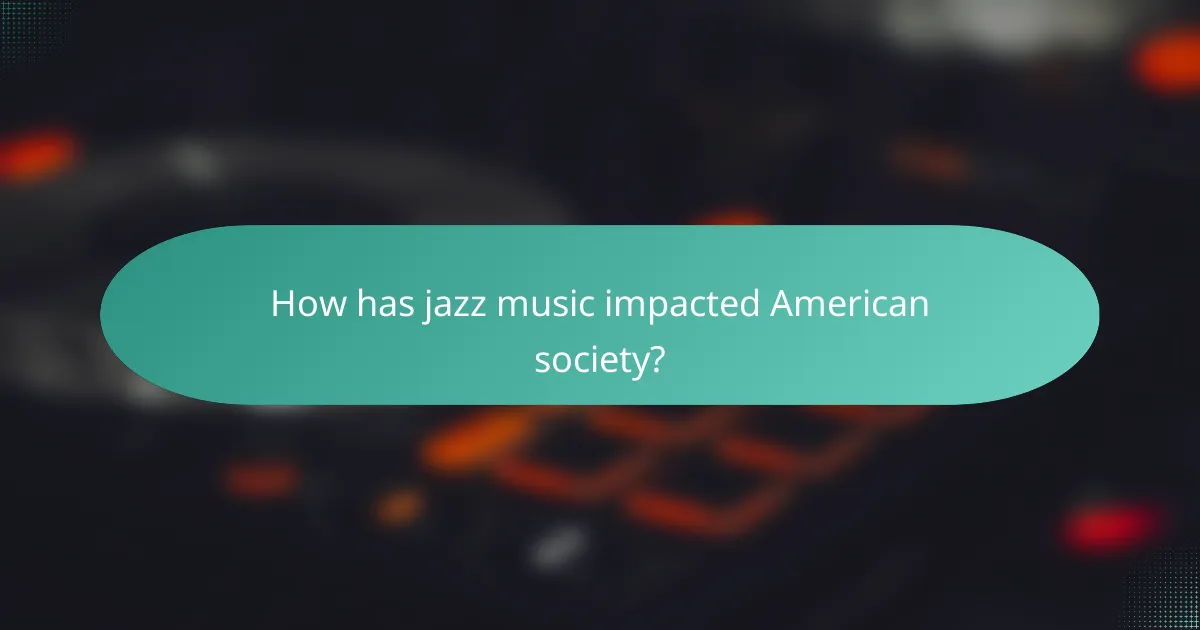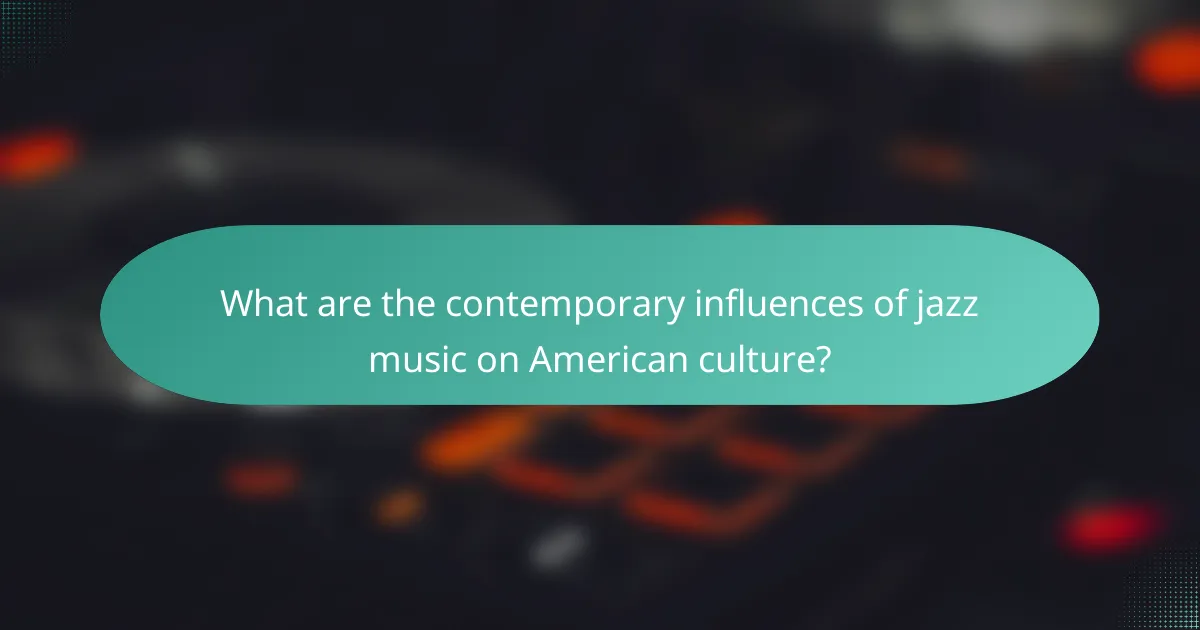Jazz music is a significant cultural entity in the United States, representing a fusion of African American and European musical traditions. Emerging in the early 20th century in New Orleans, jazz has played a vital role in cultural exchange, influencing genres such as rock, blues, and hip-hop. It served as a powerful voice during the Civil Rights Movement, with notable musicians like Louis Armstrong and Duke Ellington advocating for social justice through their art. Jazz festivals and clubs across the country celebrate this genre, while educational programs help preserve its legacy and inspire future generations. Overall, jazz continues to shape American culture by promoting diversity and artistic innovation.

What is the significance of jazz music in American culture?
Jazz music is significant in American culture as it represents a unique blend of African and European musical traditions. Originating in the early 20th century, jazz emerged primarily in New Orleans. It played a crucial role in the cultural exchange among diverse communities. Jazz has influenced various music genres, including rock, blues, and hip-hop. The genre is also a symbol of social change and civil rights movements. Notable figures like Louis Armstrong and Duke Ellington brought jazz to mainstream audiences. Jazz festivals and clubs have become cultural landmarks across the United States. The National Endowment for the Arts designated jazz as a “national treasure” in 1987, highlighting its importance.
How did jazz music originate and evolve in America?
Jazz music originated in the late 19th and early 20th centuries in New Orleans, Louisiana. It emerged from a blend of African American musical traditions, including blues, ragtime, and spirituals. The city’s diverse cultural landscape fostered this musical innovation. By the 1920s, jazz began to spread across the United States, influenced by the Great Migration, where African Americans moved northward. Major cities like Chicago and New York became jazz hubs during this time. The introduction of radio and phonograph records helped popularize jazz nationwide. Over the decades, jazz evolved into various styles, including bebop, cool jazz, and free jazz. Each style reflected social changes and artistic experimentation within the African American community and beyond. Jazz became an important cultural force, influencing other music genres and contributing to the civil rights movement.
What cultural influences shaped the development of jazz music?
Jazz music developed through a blend of African American cultural influences. African rhythms and blues music significantly shaped its early forms. The Great Migration brought Southern African Americans to urban centers, spreading jazz. New Orleans was a crucial birthplace, combining various musical traditions. European musical elements also contributed, particularly through instruments and harmony. The cultural melting pot created a unique sound. Social changes, such as the Harlem Renaissance, further fueled jazz’s evolution. These influences established jazz as a distinct and influential genre in American music history.
What were the key historical milestones in the evolution of jazz?
Jazz evolved through several key historical milestones. The origins of jazz can be traced back to the early 20th century in New Orleans. In the 1910s, jazz began to spread beyond New Orleans, particularly to Chicago. The 1920s, known as the Jazz Age, saw the rise of famous musicians like Louis Armstrong and Duke Ellington. The 1930s introduced big band and swing music, becoming popular across the United States. The bebop revolution in the 1940s brought complex harmonies and improvisation to the forefront. The 1950s and 1960s saw the emergence of cool jazz and modal jazz, with artists like Miles Davis and John Coltrane. The fusion movement in the late 1960s blended jazz with rock and funk elements. These milestones illustrate jazz’s transformation and its impact on American culture.
Why is jazz considered a form of social change in America?
Jazz is considered a form of social change in America because it broke racial barriers and fostered integration. Emerging in the early 20th century, jazz was a blend of African American musical traditions and European influences. This genre became a voice for marginalized communities during the Civil Rights Movement. Notable figures like Louis Armstrong and Duke Ellington challenged societal norms through their music. Jazz clubs became spaces where people of different races interacted. The music promoted cultural exchange and understanding. Additionally, jazz influenced other art forms, including literature and visual arts. Its improvisational nature symbolized freedom and individuality.
How did jazz music influence social movements in the 20th century?
Jazz music significantly influenced social movements in the 20th century. It served as a form of expression for marginalized communities. Jazz became a voice for the African American experience during the Civil Rights Movement. Artists like Louis Armstrong and Billie Holiday highlighted social injustices through their music. The song “Strange Fruit” by Holiday addressed racism and lynching directly. Jazz clubs became safe spaces for diverse groups to gather and unite. The genre’s improvisational nature encouraged freedom of expression and creativity. Overall, jazz music was a catalyst for social change and cultural awareness.
What role did jazz play in the Civil Rights Movement?
Jazz played a significant role in the Civil Rights Movement by serving as a form of protest and expression. Jazz musicians used their art to convey messages of freedom and equality. Notable figures like Louis Armstrong and Billie Holiday highlighted racial injustice through their music. Holiday’s song “Strange Fruit” became an anthem against lynching. Jazz performances often took place at civil rights rallies and events. These gatherings helped unify activists and spread their message. The improvisational nature of jazz symbolized the fight for personal and social freedom. Overall, jazz was both a cultural and political force during this pivotal era.

How has jazz music impacted American society?
Jazz music has significantly impacted American society by shaping cultural identity and fostering social change. It emerged in the early 20th century, blending African American musical traditions with European influences. This genre became a voice for the African American community during the Civil Rights Movement. Notable figures like Louis Armstrong and Duke Ellington challenged racial barriers through their music. Jazz also influenced other genres, including rock and hip-hop, promoting cross-cultural collaboration. The establishment of jazz clubs in cities like New Orleans and New York created vibrant social spaces for diverse audiences. Additionally, jazz has been recognized as a significant American art form, celebrated in festivals and educational programs across the country. Its improvisational nature encourages creativity and expression, reflecting the dynamic spirit of American culture.
What are the primary cultural contributions of jazz music?
Jazz music significantly contributes to cultural identity and social change. It emerged as a powerful form of expression during the early 20th century. Jazz has roots in African American communities, blending African rhythms, blues, and ragtime. This genre fostered a sense of community and cultural pride among its listeners.
Jazz also played a crucial role in the civil rights movement. Artists like Louis Armstrong and Billie Holiday used their platforms to address social issues. The song “Strange Fruit,” performed by Holiday, highlighted racial violence and injustice.
Moreover, jazz influenced various art forms, including literature and visual arts. Writers like Langston Hughes incorporated jazz rhythms into their poetry. Visual artists, such as Romare Bearden, drew inspiration from jazz’s improvisational nature.
Internationally, jazz has impacted global music scenes, promoting cultural exchange. It has inspired genres like bossa nova in Brazil and Afrobeat in Nigeria. Jazz festivals around the world celebrate this rich cultural heritage.
Overall, jazz music serves as a symbol of resilience, creativity, and social progress. Its contributions continue to shape cultural narratives and inspire future generations.
How has jazz music influenced other music genres?
Jazz music has significantly influenced various music genres including rock, hip-hop, and R&B. Its improvisational style introduced new rhythms and harmonies. Rock music adopted jazz’s syncopation and swing elements. Hip-hop artists often sample jazz tracks, integrating its complex melodies. R&B incorporates jazz’s emotional expressiveness and instrumental techniques. The fusion genre blends jazz with rock and funk, showcasing its versatility. Jazz’s influence is evident in the works of artists like Miles Davis and John Coltrane, who inspired countless musicians across genres. This cross-pollination has enriched the musical landscape, creating diverse soundscapes and innovative styles.
In what ways has jazz music shaped American identity?
Jazz music has significantly shaped American identity through its cultural integration and innovation. Originating in the early 20th century, jazz emerged from African American communities. It blended African rhythms, blues, and European musical traditions. This fusion created a unique sound that represented diversity in America. Jazz became a symbol of freedom and expression during the Harlem Renaissance. It challenged social norms and promoted racial integration. Notable figures like Louis Armstrong and Duke Ellington influenced mainstream music. The genre’s improvisational nature reflects American values of creativity and individuality. Jazz festivals and clubs became cultural landmarks across the nation. This music continues to resonate, influencing contemporary genres and artists.
How does jazz music reflect social issues in America?
Jazz music reflects social issues in America by serving as a voice for marginalized communities. It originated in the early 20th century, rooted in African American experiences. The genre often addresses themes of struggle, resilience, and identity. For example, songs like “Strange Fruit” highlight the horrors of racial violence. The improvisational nature of jazz symbolizes freedom and resistance against oppression. Additionally, jazz has evolved through various social movements, including the Civil Rights Movement. Artists like Louis Armstrong and Duke Ellington used their platforms to advocate for equality. The music continues to resonate with contemporary social issues, reflecting ongoing challenges in American society.
What themes in jazz music address societal challenges?
Jazz music addresses societal challenges through themes of racial inequality, social justice, and personal freedom. These themes reflect the struggles and aspirations of marginalized communities. For instance, the Civil Rights Movement inspired numerous jazz compositions that highlighted the fight against racism. Notable works like “Strange Fruit” by Billie Holiday poignantly address racial violence. Additionally, jazz often serves as a platform for expressing dissent and advocating for change. The improvisational nature of jazz allows artists to respond to societal issues in real-time. This genre has historically provided a voice for the oppressed, making it a powerful tool for social commentary.
How do jazz musicians use their art to comment on social issues?
Jazz musicians use their art to comment on social issues by incorporating themes of struggle, resistance, and identity in their music. They express societal challenges through improvisation and lyrical content. For example, songs like “Strange Fruit” by Billie Holiday addressed racism and lynching in America. This song became a powerful protest anthem during the Civil Rights Movement. Jazz also served as a platform for musicians to voice their experiences with inequality. Artists like John Coltrane and Charles Mingus tackled issues of social justice in their compositions. The improvisational nature of jazz allows musicians to convey emotions and narratives related to their social contexts. Through performances and recordings, they raise awareness and provoke thought on critical issues affecting society.

What are the contemporary influences of jazz music on American culture?
Jazz music significantly influences contemporary American culture through its impact on various genres, social movements, and artistic expressions. It serves as a foundation for genres like rock, hip-hop, and R&B. Many contemporary artists incorporate jazz elements into their music, showcasing its versatility. Jazz has also influenced fashion trends, with styles reflecting the improvisational spirit of the genre.
Moreover, jazz music plays a crucial role in social movements, particularly in civil rights activism. Iconic jazz musicians used their platforms to advocate for equality and social justice. Events like the Newport Jazz Festival celebrate this cultural heritage, promoting community engagement and appreciation for diversity.
Additionally, jazz education programs in schools foster creativity and critical thinking among students. These programs help preserve the genre’s legacy while inspiring new generations of musicians. Overall, jazz continues to shape American culture by bridging gaps between different communities and inspiring artistic innovation.
How is jazz music being preserved and promoted today?
Jazz music is being preserved and promoted today through educational programs, festivals, and digital platforms. Schools and universities offer jazz studies to teach students about its history and techniques. Organizations like the Jazz Foundation of America support musicians and heritage preservation. Annual festivals celebrate jazz, attracting both audiences and performers. Online streaming services provide access to a wider audience, showcasing classic and contemporary jazz. Social media platforms help connect artists with fans and promote new works. Additionally, documentaries and films highlight jazz legends, further raising awareness. These efforts ensure that jazz remains a vital part of cultural heritage.
What initiatives support jazz education and appreciation?
Initiatives that support jazz education and appreciation include programs by organizations like Jazz at Lincoln Center. These programs provide educational resources and workshops for students and educators. The National Endowment for the Arts also funds jazz education initiatives across the United States. Local community programs often host jazz festivals that include educational components. Schools may offer jazz bands and courses to teach students about jazz history and performance. Additionally, online platforms provide access to jazz lessons and resources. These initiatives enhance understanding and foster a love for jazz music.
How do modern artists incorporate jazz elements into their work?
Modern artists incorporate jazz elements into their work through various techniques and styles. They often blend improvisation, syncopation, and rhythmic complexity characteristic of jazz. This integration can be seen in visual arts, where artists use dynamic compositions reminiscent of jazz performances. In literature, authors adopt jazz-inspired rhythms and structures in their writing. Musicians fuse jazz with other genres, creating hybrid styles that reflect contemporary influences. For example, hip-hop artists frequently sample jazz tracks, infusing their music with rich musical heritage. These practices highlight the ongoing relevance and adaptability of jazz in modern artistic expressions.
What practices can help deepen appreciation for jazz music?
Listening to diverse jazz recordings can deepen appreciation for jazz music. Exploring various subgenres such as bebop, swing, and fusion reveals the genre’s complexity. Attending live jazz performances provides an immersive experience of the music’s energy and spontaneity. Engaging with jazz history through documentaries and books enhances understanding of its cultural context. Participating in discussions or forums about jazz encourages sharing insights and interpretations. Learning to play a jazz instrument fosters a personal connection to the music. Analyzing jazz compositions and improvisations develops critical listening skills. These practices collectively enrich the listener’s experience and appreciation of jazz music.
How can listeners engage with jazz music beyond passive listening?
Listeners can engage with jazz music beyond passive listening by participating in live performances. Attending concerts allows listeners to experience the energy and improvisation of jazz firsthand. Joining jazz workshops or classes enables individuals to learn about the genre and even play instruments. Engaging with jazz communities online fosters discussions and sharing of personal interpretations. Listening to jazz radio stations or podcasts deepens understanding through curated content and expert insights. Exploring jazz history through documentaries and books enhances appreciation of its cultural significance. Each of these activities encourages active involvement and a deeper connection to jazz music.
What resources are available for learning more about jazz music?
Books on jazz music include “The Jazz Book” by Joachim-Ernst Berendt and “The History of Jazz” by Ted Gioia. Online courses are available through platforms like Coursera and MasterClass. Documentaries such as “Jazz” by Ken Burns provide in-depth historical context. Websites like the National Jazz Museum offer educational resources. Local libraries often have jazz music collections and archives. Music streaming services feature playlists and artist profiles dedicated to jazz. Additionally, community colleges may offer jazz appreciation classes. These resources collectively enhance understanding of jazz music’s influence and significance.
The main entity of this article is jazz music and its influence on American culture. The article examines the historical significance of jazz, tracing its origins in New Orleans and its evolution through key milestones, cultural influences, and social movements, particularly during the Civil Rights Movement. It highlights how jazz has served as a form of social change, reflecting societal challenges and contributing to cultural identity. Additionally, the article discusses contemporary influences of jazz, its role in education, and initiatives promoting its appreciation and preservation in modern society.